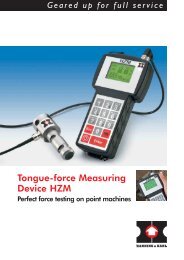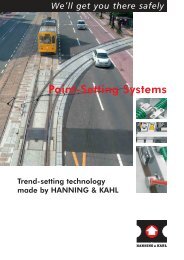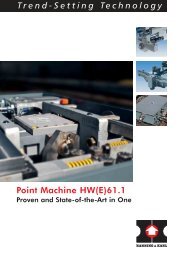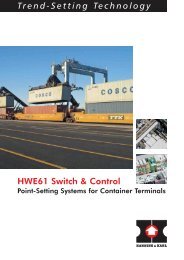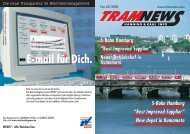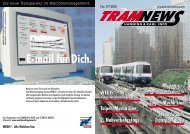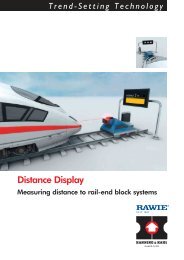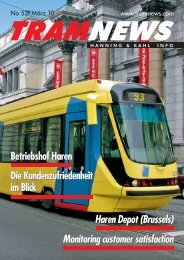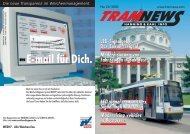Ein Notlösegerät für alle Fälle Gent Prüfung von ... - Hanning & Kahl
Ein Notlösegerät für alle Fälle Gent Prüfung von ... - Hanning & Kahl
Ein Notlösegerät für alle Fälle Gent Prüfung von ... - Hanning & Kahl
Sie wollen auch ein ePaper? Erhöhen Sie die Reichweite Ihrer Titel.
YUMPU macht aus Druck-PDFs automatisch weboptimierte ePaper, die Google liebt.
EXTERN/EXTERNAL<br />
Feldbus ersetzt Kabelsalat<br />
Fieldbus replaces cable salad<br />
Der <strong>Ein</strong>satz <strong>von</strong> Feldbus-Systemen in der Automatisierungstechnik<br />
ist mit einer großen Zahl <strong>von</strong> technischen und ökonomischen<br />
Vorteilen verbunden. Der Feldbus hat praktisch <strong>alle</strong><br />
Bereiche der digitalen und analogen Steuerungsperipherie erobert.<br />
Bei der Entwicklung der Feldbus-Systeme ging es<br />
zunächst darum, den Verdrahtungsaufwand zu verringern.<br />
Später kam die vereinfachte System-Diagnose durch intelligente<br />
Feldgeräte hinzu, die Störungen und Fehlermeldungen<br />
schnell und detailliert zur Steuerung übertragen können.<br />
Schließlich wurden die Feldgeräte mit Steuerungsfunktionalität<br />
zur dezentralen Datenvorverarbeitung und für einfache<br />
Regelungsaufgaben ausgestattet – und Feldbusse zur Kommunikation<br />
eingesetzt.<br />
Der Automatisierungsmarkt bietet<br />
für unterschiedliche Anwendungen<br />
eine Vielzahl <strong>von</strong> <strong>von</strong> verschiedenen<br />
Feldbus-Systemen.<br />
Die Anwendungsgebiete stellen<br />
verschiedene Anforderungen an<br />
das Bussystem, z. B. hohe Geschwindigkeit,<br />
Störungssicherheit,<br />
einfache Bedienung und Inbetriebnahme<br />
oder niedrige Kosten.<br />
Aus diesen Gründen wurden für<br />
die verschiedenen <strong>Ein</strong>satzgebiete<br />
unterschiedliche Feldbussysteme<br />
entwickelt, wie z. B.:<br />
– Profibus-DP/FMS<br />
– Interbus, CANopen<br />
– DeviceNet<br />
– ControlNet<br />
– Beckoff Lightbus<br />
– Sercos<br />
– Ethernet TCP/IP, USB, RS485,<br />
RS232<br />
Die meisten am Markt verfügbaren<br />
Feldbusbaugruppen, als Bindeglied<br />
zwischen Steuerung und<br />
Aktorik/Sensorik, sind nur für<br />
einen bestimmten Feldbus ausgelegt.<br />
D. h. beim Wechsel des<br />
Feldbussystems wird die komplette<br />
Baugruppe ausgetauscht. Nicht<br />
so beim Beckhoff Busklemmen System:<br />
die Busklemme ist ein offenes<br />
und feldbus-neutrales Peripheriekonzept,<br />
bestehend aus<br />
elektronischen Reihenklemmen.<br />
Der Kopf einer elektronischen<br />
Reihenklemme ist der Buskoppler<br />
mit der Schnittstelle für den Feldbus.<br />
Intelligente Reihenklemmen<br />
Die Busklemme ist eine Reihenklemme<br />
mit elektronischem „intelligentem“<br />
Innenleben und entspricht<br />
mit einer Breite <strong>von</strong> 12 mm<br />
einer mechanischen Doppelklemme.<br />
Mit diesen Grundelementen<br />
kann eine Klemmleiste mit Feldbusanschluss<br />
so aufgebaut werden,<br />
dass Signale völlig frei<br />
mischbar mit einer Modularität<br />
<strong>von</strong> 2- und 4-Kanälen angeordnet<br />
werden, wie man es <strong>von</strong> der<br />
Reihenklemmtechnik gewohnt ist.<br />
Die feinmodularen Busklemmen<br />
sind gegenüber den am Markt<br />
verfügbaren 8er-, 16er- oder<br />
32er-Klemmenblöcken flexibler<br />
und für kostengünstig individuellere<br />
Lösungen geeignet. In der<br />
Praxis haben die Busklemmen den<br />
Vorteil, dass die Verdrahtung an<br />
der Maschine erfolgt. Nach Bedarf<br />
wirt dort eine Busklemme<br />
aufgesteckt und der Datenaustausch<br />
mit der Steuerung ist unkompliziert<br />
hergestellt.<br />
Anreihbar wie eine Standard-Reihenklemme<br />
schliesst man bei der<br />
elektronischen Version bereits<br />
beim <strong>Ein</strong>setzen den systeminternen<br />
Bus und die Versorgungsspannung<br />
samt Schutzerde an.<br />
Dabei bleibt jedes Modul einzeln<br />
austauschbar und lässt sich praktisch<br />
an jeder Stelle des Systems<br />
aufsetzen. Die beim Aufbau einer<br />
Klemmleiste benötigten Potentialgruppen<br />
unterstützt das System<br />
durch die völlige Potentialtrennung<br />
der Klemmen untereinander.<br />
Die <strong>Ein</strong>speisung der Leistungspotentiale<br />
für die E/A-Ebene<br />
können über einfügbare Potentialeinspeisungsklemmen<br />
vorgenommen<br />
werden. Seitlich an<br />
den Klemmen angeordnete Powerkontakte<br />
sorgen für die automatische<br />
Brückung dieser Leistungspotentiale<br />
<strong>von</strong> Klemme zu<br />
Klemme: Damit entfällt ein kompletter<br />
Arbeitsgang zur Verdrahtung<br />
der E/A-Ebene.<br />
Die Beckhoff Busklemme sorgt<br />
dafür, dass Schaltschränke und<br />
Klemmkästen wirtschaftlicher<br />
gebaut werden. Alle gängigen<br />
Sensoren und Aktoren mit unterschiedlichen<br />
Signalarten können<br />
direkt angeschlossen werden.<br />
The Beckhoff Bus Terminal<br />
ensures that control cabinets and<br />
terminal boxes are constructed<br />
more economically. All of the<br />
usual sensors and actuators with<br />
different types of signal can be<br />
connected directly without other<br />
connection systems.<br />
Signal- und Feldbusunabhängigkeit<br />
in einem System<br />
Das Busklemmen System läßt den<br />
Anschluss <strong>von</strong> bis zu 64 Klemmen<br />
an einer Station zu. Bei Verwendung<br />
einer digitalen 4-Kanal-<br />
Klemme stehen somit bis zu 256<br />
digitale und 128 analoge <strong>Ein</strong>oder<br />
Ausgänge zur Verfügung.<br />
Mit über 80 unterschiedlichen<br />
Feldbusklemmen können <strong>alle</strong><br />
gängigen Sensoren und Aktoren<br />
mit unterschiedlichen Signalarten<br />
direkt, ohne weitere Verbindungstechnik<br />
angeschlossen werden.<br />
Neben den zweikanalig ausgeführten,<br />
digitalen <strong>Ein</strong>- und Ausgangsklemmen<br />
gibt es analoge<br />
Varianten, für Ströme und Spannungen<br />
in standardisierten Signalpegeln<br />
sowie für PT100 und<br />
Thermoelemente. Über eine<br />
Klemme mit serieller Schnittstelle,<br />
gemäss RS232/RS485 oder 20<br />
mA Current Loop, lassen sich intelligente<br />
Geräte anschliessen<br />
und parametrieren. Aber auch<br />
Varianten für Signalpegel aus der<br />
Winkel- und Wegmessung sind<br />
verfügbar.<br />
The application of fieldbus systems in automation technology is<br />
associated with many technical and economic advantages. The<br />
fieldbus has established itself in almost all sectors of digital and<br />
analogue control peripheral equipment. The first goal in developing<br />
fieldbus systems was a reduction in the amount of wiring.<br />
Simplified system diagnostics, enabled by intelligent field devices<br />
that could send detailed information about malfunctions and<br />
errors quickly to the controller, came later. Finally the field devices<br />
were given controller functionality for distributed data preprocessing<br />
and for simple control tasks – and fieldbusses were<br />
used for communication.<br />
A wide range of different fieldbus<br />
systems for various applications<br />
are available on the automation<br />
market. The conditions of the applications<br />
place different demands<br />
on the bus system, e.g.<br />
high speed, freedom from error,<br />
simple operation and startup or<br />
low cost. For these reasons, differing<br />
fieldbus systems have been<br />
developed for these various application<br />
types, such as:<br />
– Profibus DP/FMS<br />
– Interbus<br />
– CANopen<br />
– DeviceNet<br />
– ControlNet<br />
– Beckhoff Lightbus<br />
– Sercos<br />
– Ethernet TCP/IP, USB, RS485,<br />
RS232<br />
Most of the fieldbus modules<br />
available on the market, which<br />
act as the link between the controller<br />
and the actuators and sensors,<br />
are only designed for one<br />
particular fieldbus. This means<br />
that if the fieldbus system is changed,<br />
the entire module must be<br />
replaced. This is not the case for<br />
the Beckhoff Bus Terminal system:<br />
the Bus Terminal is an open peripheral<br />
design, consisting of stackable<br />
electronic series terminals,<br />
and not restricted to any particular<br />
fieldbus. The head of an electronic<br />
series terminal is the Bus<br />
Coupler with the interface to the<br />
fieldbus.<br />
Intelligent Terminal Blocks<br />
The Beckhoff Bus Terminal is a<br />
terminal block containing its own<br />
electronic “intelligence“, whose 12<br />
mm width corresponds mechanically<br />
to a double terminal. Using<br />
these elements, a terminal row<br />
with a fieldbus connection can be<br />
constructed in such a way that<br />
signals can be mixed quite freely,<br />
with a modularity of 2 and 4<br />
channels, in the way familiar from<br />
terminal block technology. The<br />
fine modularity of Beckhoff Bus<br />
Terminals makes them more flexible<br />
than those terminal blocks<br />
on the market with 8, 16 or 32<br />
channels, and so suitable for more<br />
individual, cost-effective solutions.<br />
In practice, the Bus Terminals have<br />
the advantage that the field devices<br />
can be wired flexibly and<br />
Feldbusunabhängige Busklemmen<br />
<strong>von</strong> Beckoff – der universelle<br />
Grundbaustein für die<br />
Automatisierung<br />
locally, at the machine. A Bus<br />
Terminal is inserted there as<br />
required, and the data exchange<br />
with the controller is established in<br />
an uncomplicated manner.<br />
Like standard terminal blocks,<br />
they can be assembled into a row,<br />
and the connections for the internal<br />
system bus, electrical supply<br />
and protective earth of the electronic<br />
versions are made as they<br />
are inserted. Thus each module<br />
can be individually exchanged,<br />
and can be used at almost any<br />
location within the system.<br />
The system supports the potential<br />
groups needed for the construction<br />
of a terminal row through<br />
the complete potential isolation of<br />
the terminals from one another.<br />
The power voltage feed for the<br />
I/O level can be made by inserting<br />
potential feed terminals. Power<br />
contacts located at the sides<br />
of the terminals provide the automatic<br />
bridging of these power<br />
voltages from one terminal to the<br />
next: in this way an entire working<br />
process, normally involved in<br />
wiring to the I/O level, is eliminated.<br />
Fieldbus-independent Bus Terminal<br />
from Beckoff – the modular<br />
system for automation<br />
Independence from Signals<br />
and Fieldbusses in one System<br />
The Bus Terminal system allows<br />
up to 64 terminals to be connected<br />
to one station. Using a digital<br />
4-channel terminal, this means<br />
that up to either 256 digital<br />
or 128 analogue inputs or<br />
outputs are available. With more<br />
than 80 different fieldbus terminals,<br />
all common sensors or<br />
actuators with their different types<br />
of signal can be directly connected,<br />
without the need for any<br />
other connecting equipment. In<br />
addition to the twin-channel digital<br />
input and output terminals,<br />
there are analogue versions for<br />
current and voltage with standard<br />
signal levels as well as for PT100<br />
and thermocouples. Intelligent<br />
devices can be connected and<br />
parameterised via a terminal with<br />
an RS232/RS485 or 20 mA current<br />
loop serial interface. Versions<br />
for signal levels derived from<br />
angle an path measurements are<br />
also available.<br />
12<br />
13




